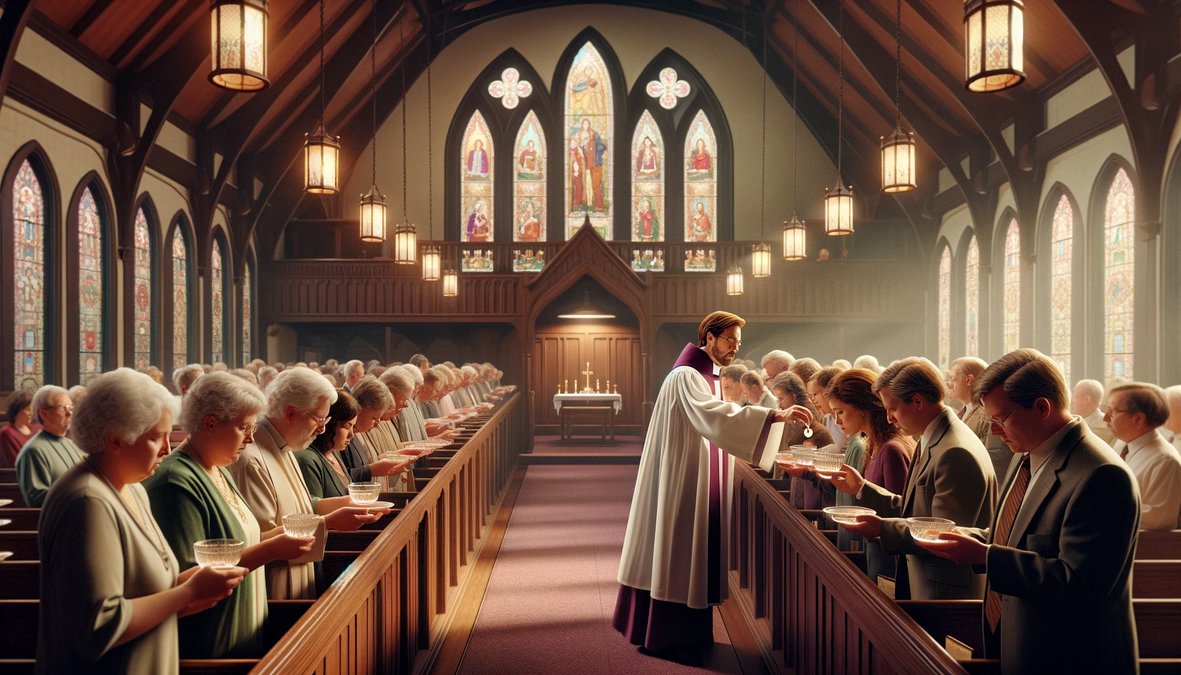Home>Theology and Spirituality>How Often Do Methodists Have Communion


Theology and Spirituality
How Often Do Methodists Have Communion
Published: February 24, 2024
Ericka Andersen, an editor at Christian.net, expertly merges digital strategy with content creation, focusing on faith and societal issues. Her communication skills enhance the platform's engaging narratives, fostering meaningful dialogue on belief's impact on society.
Discover the frequency of communion in Methodism and its significance in theology and spirituality. Learn how Methodists practice this sacred ritual.
(Many of the links in this article redirect to a specific reviewed product. Your purchase of these products through affiliate links helps to generate commission for Christian.net, at no extra cost. Learn more)
Table of Contents
Introduction
Communion, also known as the Eucharist or the Lord's Supper, holds a central place in the worship and spiritual life of the Methodist Church. It is a sacred ritual that symbolizes the spiritual nourishment and unity of believers with Christ and with one another. The practice of communion in Methodism is deeply rooted in the teachings of John Wesley, the founder of the Methodist movement, and continues to be a significant aspect of Methodist worship services across the globe.
In this article, we will explore the frequency of communion in traditional and contemporary Methodist churches, shedding light on the factors that influence the practice within the Methodist tradition. Understanding the significance and frequency of communion in Methodism is essential for both members of the Methodist community and individuals seeking to gain insight into the spiritual practices of this denomination.
Communion in the Methodist Church is not merely a symbolic ritual but a profound act of spiritual significance. It serves as a means of grace, through which Methodist believers experience the presence of Christ and the renewal of their faith. The act of partaking in communion is a tangible expression of the Methodist belief in the real presence of Christ in the bread and wine, as well as a demonstration of the community's unity in Christ.
As we delve into the frequency of communion in traditional and contemporary Methodist churches, it is important to recognize the diverse approaches to this sacred practice within the Methodist tradition. By examining the historical and theological underpinnings of communion in Methodism, we can gain a deeper appreciation for its role in shaping the spiritual identity and worship practices of Methodist congregations.
Read more: How Often Do Baptist Churches Have Communion
The Importance of Communion in the Methodist Church
Communion holds profound significance within the Methodist Church, serving as a sacred sacrament that embodies the spiritual nourishment and unity of believers with Christ and one another. Rooted in the teachings of John Wesley, the founder of Methodism, communion is regarded as a means of grace through which Methodist believers encounter the living presence of Christ.
Central to the Methodist understanding of communion is the concept of the real presence of Christ in the elements of bread and wine. This belief, often referred to as the doctrine of the "real presence," emphasizes the spiritual reality of Christ's presence during the act of communion. For Methodists, partaking in the Eucharist is not merely a symbolic gesture but a transformative encounter with the living Christ, fostering spiritual growth and renewal.
Furthermore, communion in the Methodist tradition underscores the communal aspect of faith. As believers gather around the communion table, they symbolize their unity with Christ and with one another as members of the body of Christ. This communal aspect of communion reflects the Methodist emphasis on the interconnectedness of the faith community and the shared experience of God's grace.
In addition to its spiritual significance, communion in the Methodist Church serves as a tangible expression of gratitude and remembrance. Methodists view the act of partaking in the Eucharist as a solemn remembrance of Christ's sacrificial love and a celebration of the redemptive work accomplished through his death and resurrection. This act of remembrance reinforces the foundational Christian belief in the atoning work of Christ and the promise of salvation for all who believe.
Moreover, communion plays a vital role in nurturing the spiritual life of Methodist believers. Through the partaking of the bread and wine, Methodists experience a deepening of their faith, a sense of spiritual nourishment, and a renewal of their commitment to Christ and the Christian community. This spiritual nourishment is integral to the Methodist understanding of communion as a means through which God's grace is imparted to believers, strengthening their faith and empowering them to live out their Christian calling.
In summary, the importance of communion in the Methodist Church cannot be overstated. It is a sacred sacrament that embodies the real presence of Christ, fosters communal unity, serves as a remembrance of Christ's sacrifice, and nurtures the spiritual life of believers. Understanding the profound significance of communion in Methodism provides insight into the rich spiritual heritage and worship practices of the Methodist tradition.
Frequency of Communion in Traditional Methodist Churches
In traditional Methodist churches, the frequency of communion varies, often reflecting the historical and theological roots of the denomination. Historically, John Wesley, the founder of Methodism, advocated for frequent participation in the sacrament of communion. He encouraged Methodists to partake in the Eucharist as often as possible, sometimes even daily, to experience the transformative grace of God through this sacred practice.
Traditional Methodist churches typically uphold Wesley's emphasis on the regular observance of communion. As a result, it is common for these congregations to celebrate the Eucharist on a monthly or bi-monthly basis. This frequency aligns with Wesley's exhortation for consistent participation in the sacrament, allowing believers to continually encounter the spiritual nourishment and renewal offered through communion.
The monthly or bi-monthly observance of communion in traditional Methodist churches serves as a deliberate reminder of the centrality of the Eucharist in the spiritual life of believers. It provides an opportunity for congregants to gather around the communion table, partake in the bread and wine, and experience the real presence of Christ in their midst. This regular rhythm of communion underscores the enduring significance of this sacred practice within the traditional Methodist context.
Furthermore, the frequency of communion in traditional Methodist churches reflects the deep theological understanding of the Eucharist as a means of grace. By partaking in the sacrament on a regular basis, believers are invited to encounter the transformative power of God's grace, leading to spiritual growth and a deepening of their faith. The consistent observance of communion in traditional Methodist churches reinforces the foundational belief in the real presence of Christ and the communal unity experienced through the sharing of the bread and wine.
Overall, the frequency of communion in traditional Methodist churches aligns with the historical emphasis on regular participation in the Eucharist, rooted in the teachings of John Wesley. This practice serves as a tangible expression of the Methodist commitment to encountering the living presence of Christ and nurturing the spiritual life of believers within the context of traditional worship services.
Frequency of Communion in Contemporary Methodist Churches
In contemporary Methodist churches, the frequency of communion exhibits a diverse and evolving pattern, reflecting the dynamic nature of worship practices within modern Methodist congregations. Unlike the standardized monthly or bi-monthly observance common in traditional settings, contemporary Methodist churches demonstrate a more varied approach to the frequency of communion, often influenced by contextual, theological, and practical considerations.
One notable trend in contemporary Methodist churches is the increased flexibility in communion scheduling. While some congregations maintain a monthly or bi-monthly rhythm, others have adopted a more frequent approach, offering communion on a weekly or even bi-weekly basis. This shift towards more frequent communion services aligns with the desire to provide congregants with greater opportunities to partake in this sacred sacrament and experience the transformative presence of Christ in their midst.
Moreover, contemporary Methodist churches often emphasize the integration of communion within special worship services and liturgical seasons. For example, the observance of communion may be intentionally tied to significant events in the liturgical calendar, such as Advent, Lent, and Easter, as well as other occasions of spiritual significance. This intentional alignment of communion with specific seasons and themes enriches the worship experience, allowing congregants to engage with the sacrament in a more meaningful and contextually relevant manner.
Additionally, contemporary Methodist churches recognize the importance of catering to the diverse needs and preferences of their congregants. As a result, some congregations offer multiple communion services on the same day, providing flexibility for individuals with varying schedules and preferences. This approach acknowledges the significance of communion as a communal act while accommodating the practical realities of modern life.
Furthermore, contemporary Methodist churches often prioritize the inclusion of communion in non-traditional worship settings, such as outdoor services, community outreach events, and small group gatherings. By extending the practice of communion beyond the confines of traditional sanctuary spaces, these churches seek to create meaningful and accessible opportunities for believers to partake in the Eucharist within the context of their everyday lives.
In summary, the frequency of communion in contemporary Methodist churches reflects a dynamic and adaptable approach, characterized by increased flexibility, intentional integration with liturgical seasons, accommodation of diverse congregational needs, and the expansion of communion into non-traditional worship settings. This evolving pattern underscores the commitment of contemporary Methodist churches to fostering a rich and inclusive worship experience centered on the transformative encounter with the living Christ through the sacred practice of communion.
Factors Influencing the Frequency of Communion in Methodism
The frequency of communion in Methodism is influenced by a myriad of factors that shape the worship practices and theological perspectives within the denomination. These factors play a pivotal role in determining how often communion is celebrated in traditional and contemporary Methodist churches, reflecting the diverse considerations that inform the observance of this sacred sacrament.
One significant factor influencing the frequency of communion in Methodism is the theological understanding of the Eucharist as a means of grace. Methodists hold a deep appreciation for the transformative power of communion, viewing it as a tangible encounter with the living presence of Christ and a source of spiritual nourishment. This theological emphasis on the efficacy of the sacrament often leads to a desire for more frequent communion services, as believers seek to avail themselves of the grace and renewal offered through the partaking of the bread and wine.
Historical and cultural influences also play a crucial role in shaping the frequency of communion in Methodism. Traditional Methodist churches, rooted in historical practices and theological traditions, often maintain a regular schedule of communion in alignment with the teachings of John Wesley and the historical emphasis on frequent participation in the Eucharist. In contrast, contemporary Methodist churches, influenced by evolving worship trends and contextual considerations, may adopt a more flexible approach to communion frequency, accommodating the diverse needs and preferences of congregants within modern cultural contexts.
The liturgical calendar and seasonal observances further impact the frequency of communion in Methodism. The intentional alignment of communion with significant liturgical seasons, such as Advent, Lent, and Easter, provides an opportunity for congregants to engage with the sacrament in a contextually relevant manner, enriching the worship experience and deepening the spiritual significance of communion within the Methodist tradition.
Moreover, practical considerations, such as the availability of clergy, the scheduling of worship services, and the logistical aspects of communion preparation, also influence the frequency of communion in Methodism. Contemporary Methodist churches, in particular, may prioritize flexibility and accessibility, offering multiple communion services and integrating the sacrament into non-traditional worship settings to accommodate the diverse needs and lifestyles of congregants.
In essence, the frequency of communion in Methodism is shaped by theological, historical, cultural, liturgical, and practical factors, reflecting the dynamic interplay of tradition, innovation, and contextual relevance within the worship practices of traditional and contemporary Methodist churches. This multifaceted influence underscores the rich diversity and adaptability of communion observance within the Methodist tradition, serving to nurture the spiritual life of believers and foster a deepened sense of unity and grace within the faith community.
Read more: How Often Do Catholics Have Communion
Conclusion
In conclusion, the frequency of communion in the Methodist Church reflects a dynamic interplay of historical, theological, cultural, and practical considerations that shape the observance of this sacred sacrament within traditional and contemporary Methodist churches. The importance of communion in Methodism cannot be overstated, as it serves as a tangible expression of the real presence of Christ, fosters communal unity, and nurtures the spiritual life of believers.
In traditional Methodist churches, the monthly or bi-monthly observance of communion aligns with the historical emphasis on regular participation in the Eucharist, rooted in the teachings of John Wesley. This practice serves as a deliberate reminder of the centrality of the Eucharist in the spiritual life of believers and underscores the enduring significance of this sacred practice within the traditional Methodist context.
Conversely, contemporary Methodist churches exhibit a more varied and adaptable approach to the frequency of communion, characterized by increased flexibility, intentional integration with liturgical seasons, accommodation of diverse congregational needs, and the expansion of communion into non-traditional worship settings. This evolving pattern underscores the commitment of contemporary Methodist churches to fostering a rich and inclusive worship experience centered on the transformative encounter with the living Christ through the sacred practice of communion.
The factors influencing the frequency of communion in Methodism, including theological understanding, historical and cultural influences, liturgical considerations, and practical aspects, collectively contribute to the diverse approaches to communion observance within the Methodist tradition. This multifaceted influence reflects the rich diversity and adaptability of communion observance, serving to nurture the spiritual life of believers and foster a deepened sense of unity and grace within the faith community.
Ultimately, the frequency of communion in the Methodist Church is a reflection of the enduring significance of this sacred sacrament as a means of grace, a symbol of communal unity, and a source of spiritual nourishment. Whether observed in traditional or contemporary contexts, communion remains a central and transformative practice that continues to shape the spiritual identity and worship experiences of Methodist congregations worldwide.














